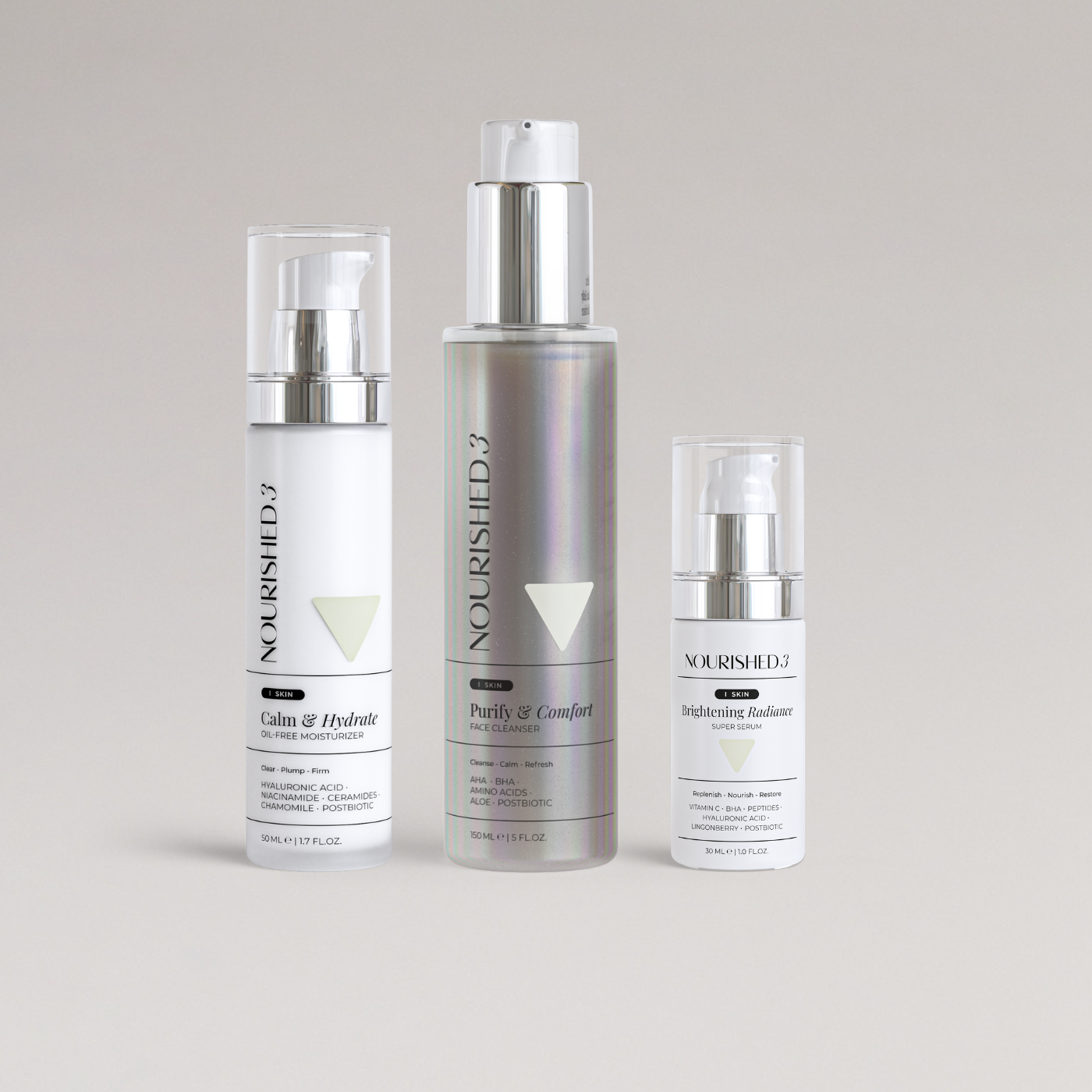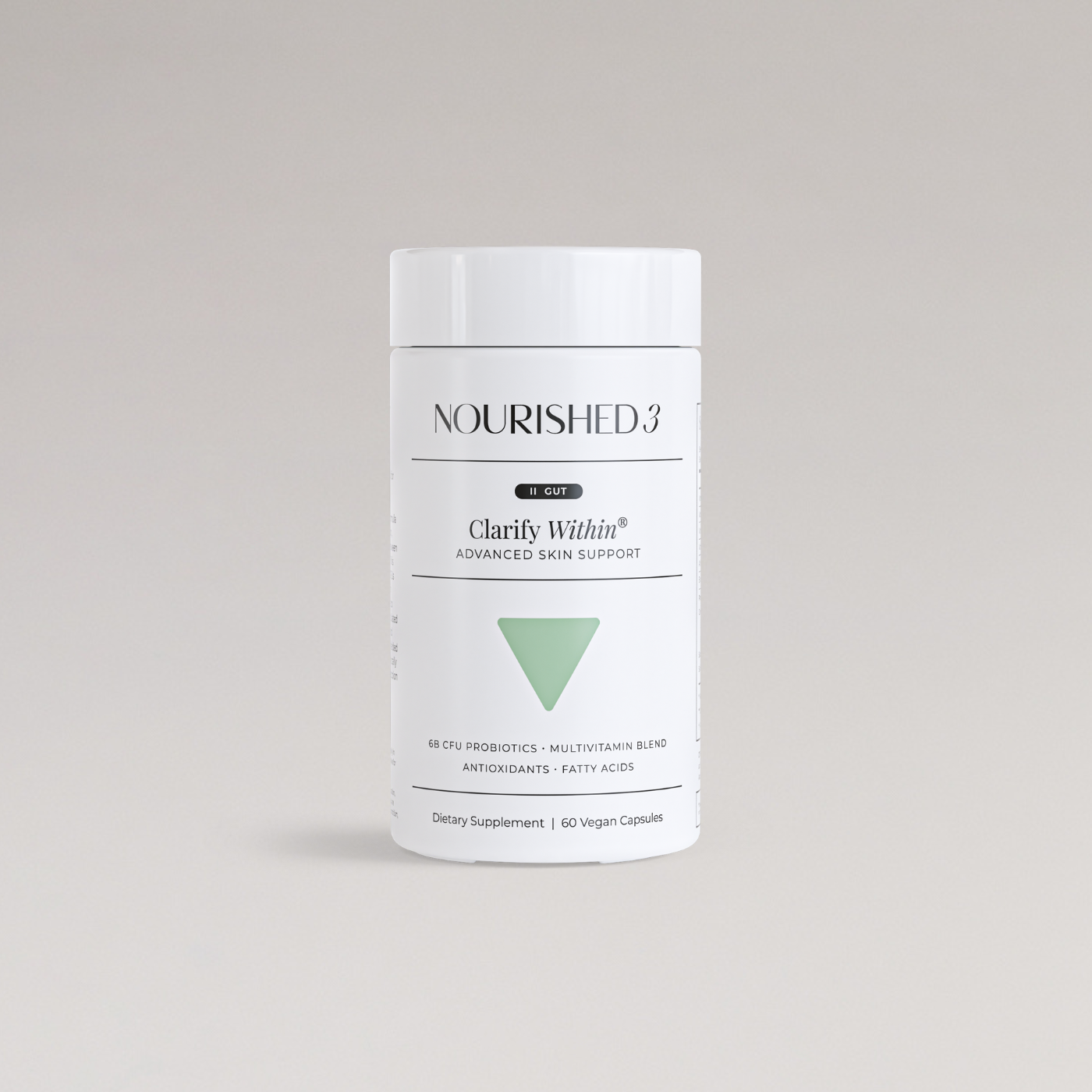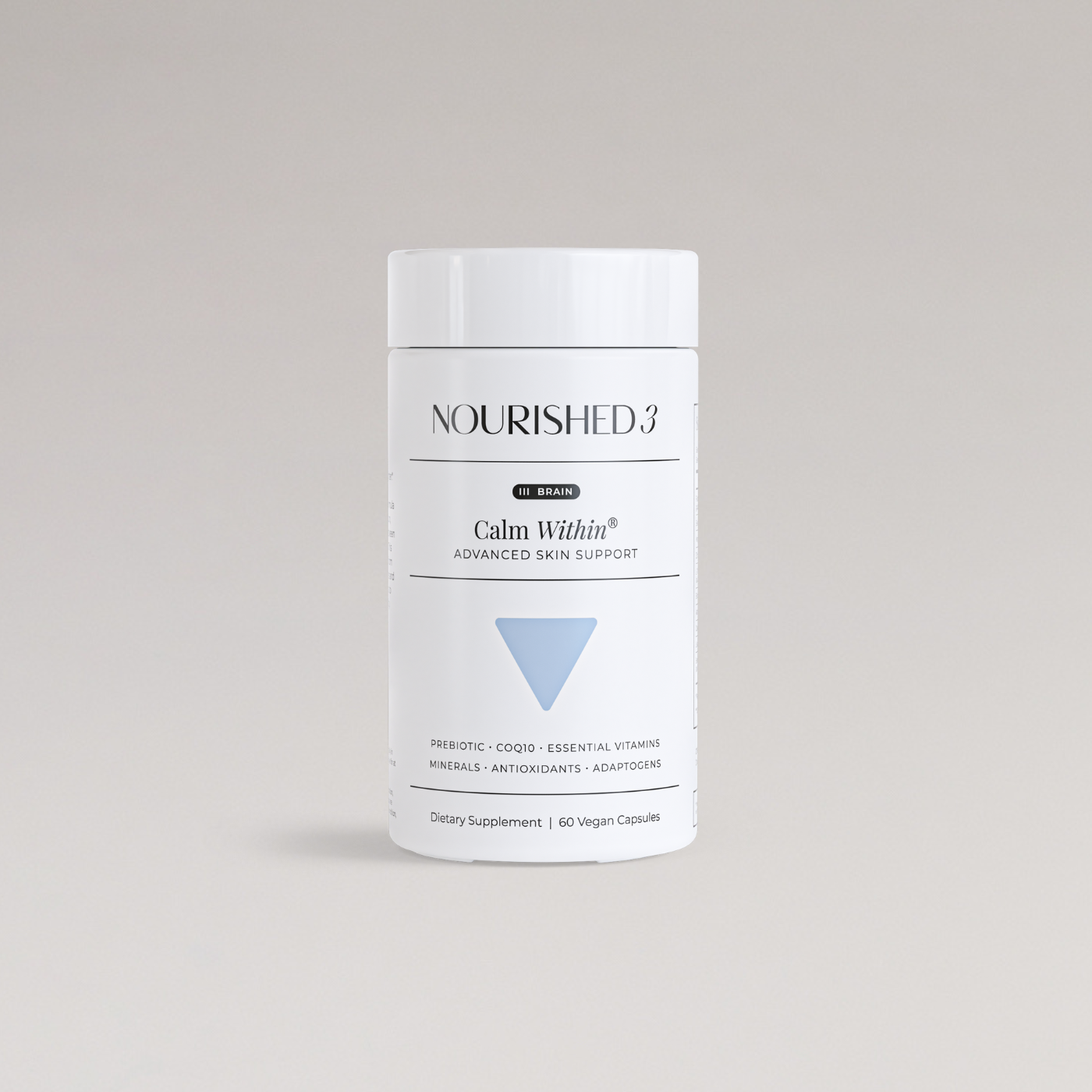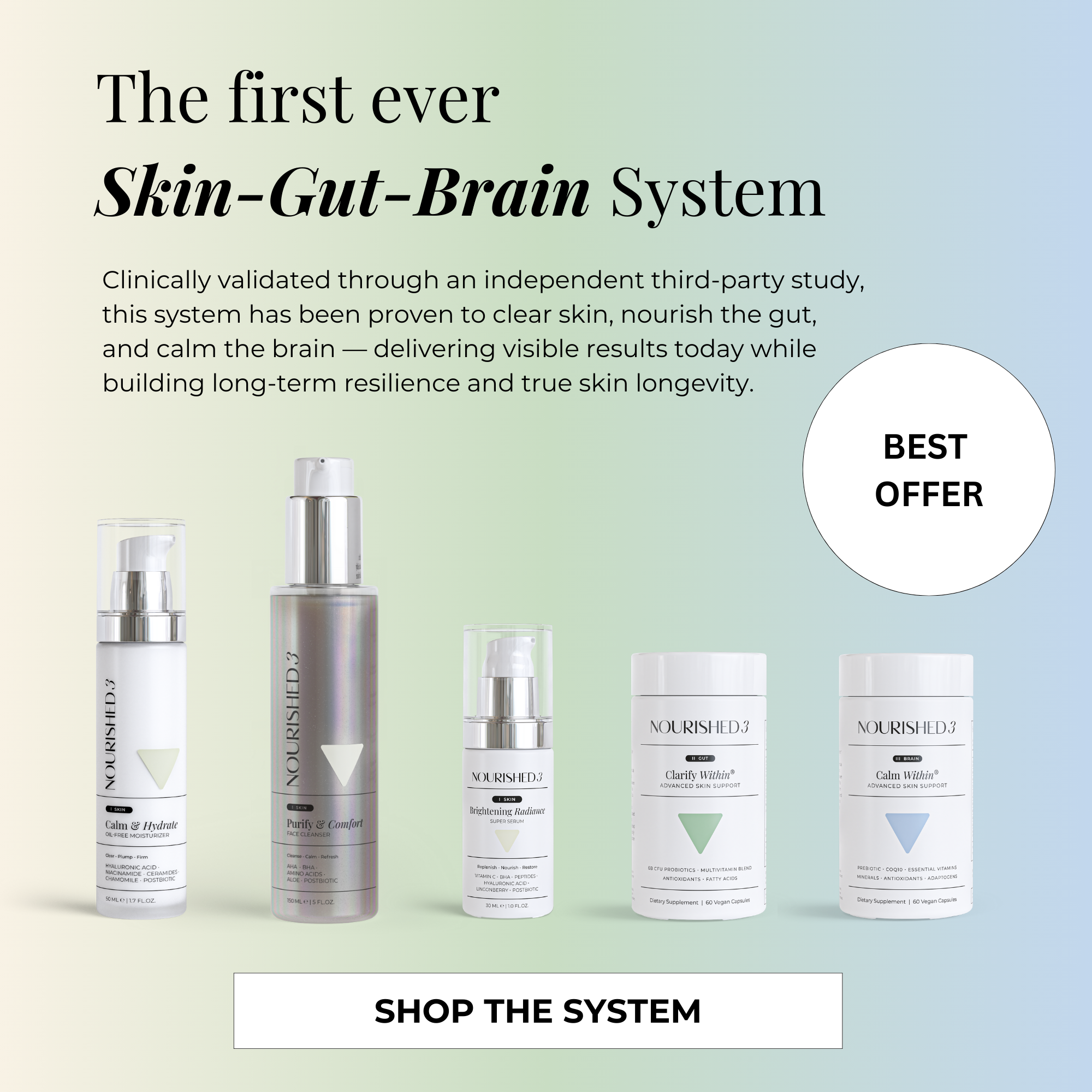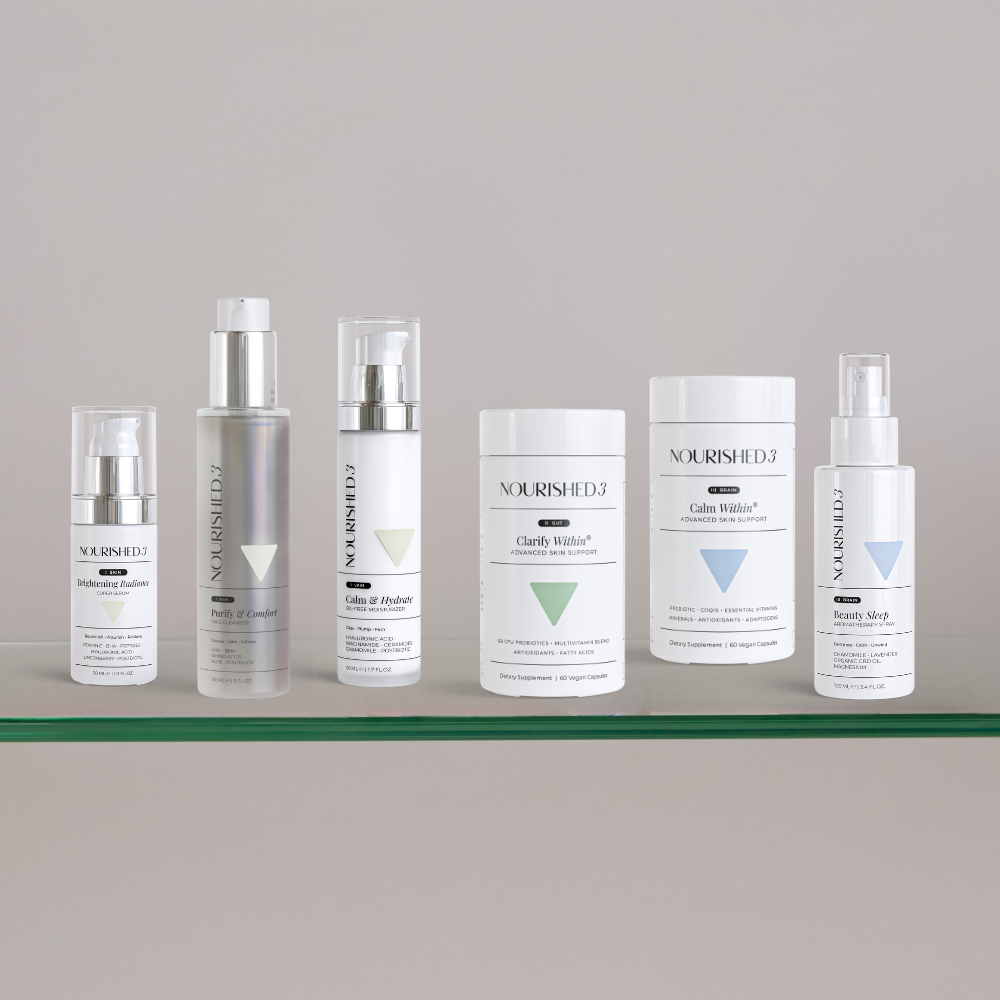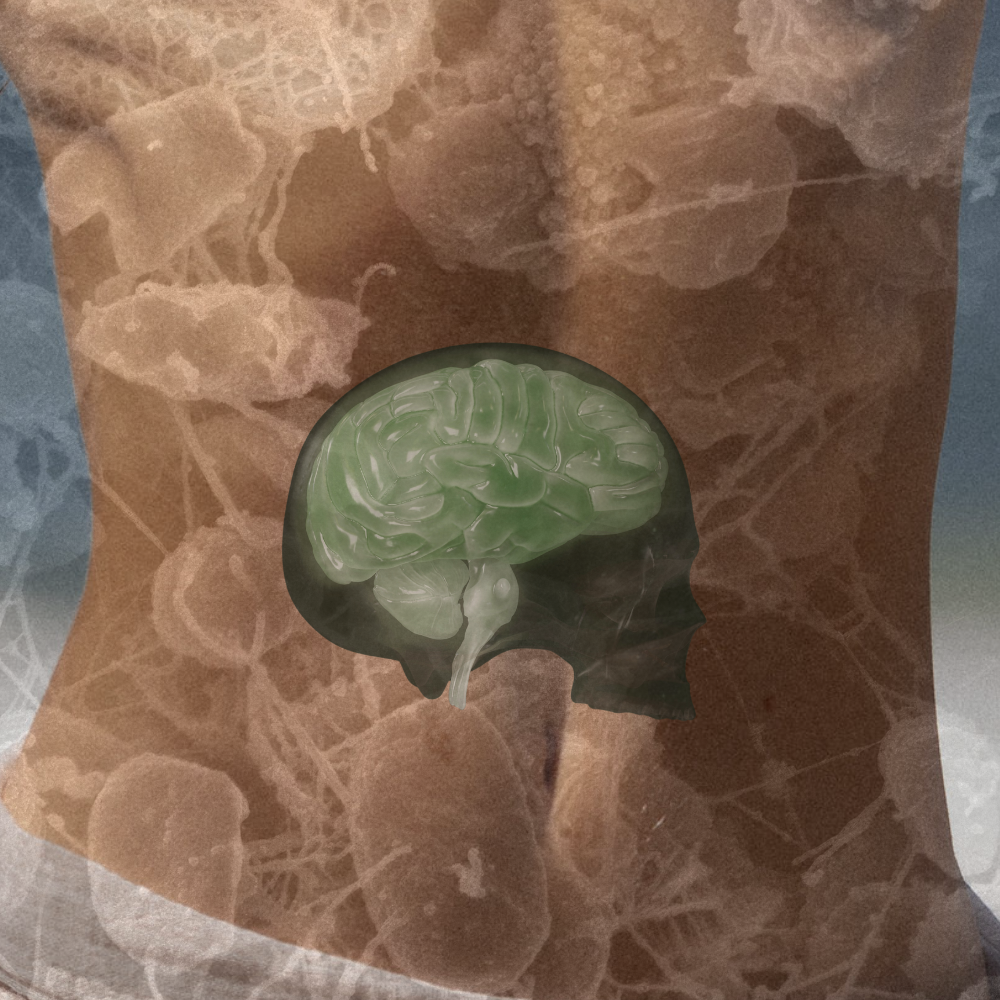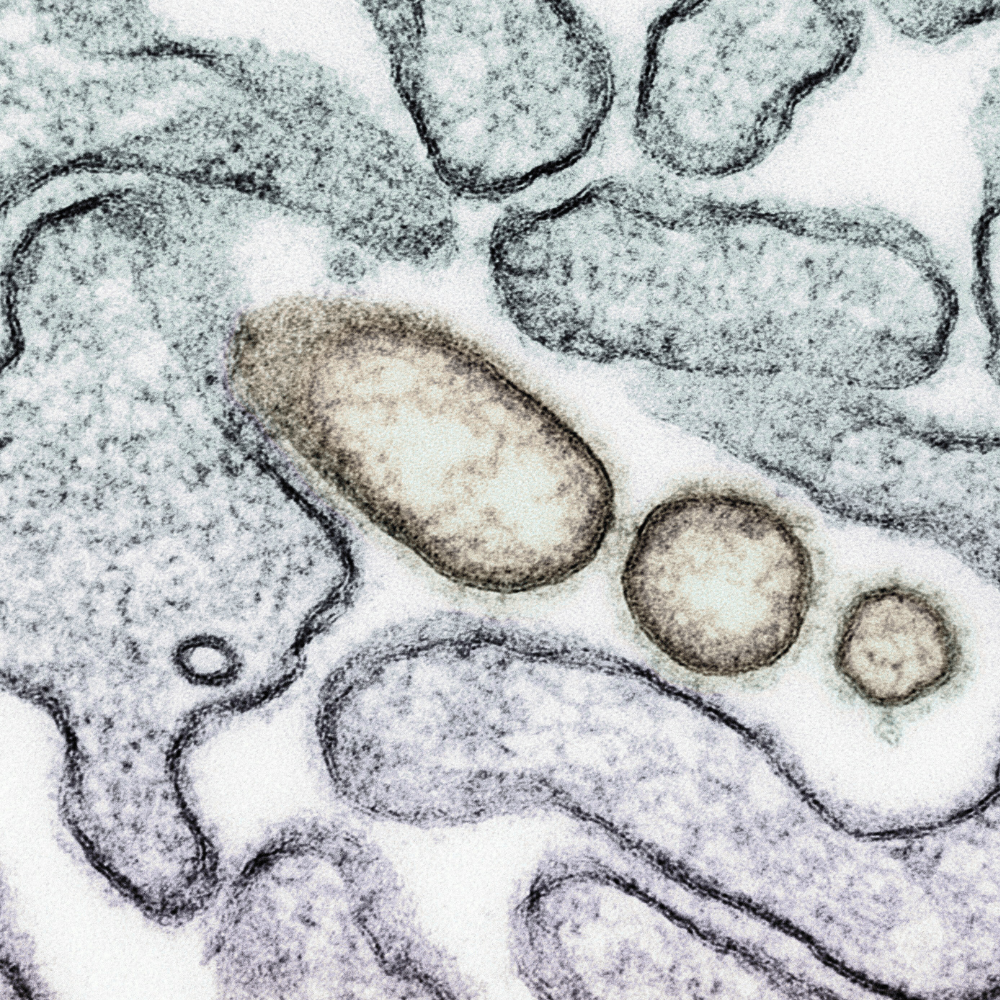Nourished3: The Triple Biotic® Skin–Gut–Brain System Advantage
5 min read
What Nourished3 Does
- Nourished3 is the skin–gut–brain brand focused on microbiome repair to support clear, healthy, resilient skin from within.
- We created the Triple Biotic™ System, a clinically informed blend of probiotics, prebiotics, postbiotics, omegas, vitamins, and barrier-strengthening skincare that works together across internal and external pathways.
- Our formulations target all three pathways of the skin–gut–brain axis: microbiome balance, inflammation reduction, and stress regulation.
- Nourished3 offers the only complete, clinically validated microbiome system featuring psychobiotics (Cerebiome®), skinbiotics (Saccharomyces boulardii), and bioactive, barrier-supportive skincare.
Together, our system improves skin clarity, gut comfort, mood balance, and overall well-being through a synergy of internal and external microbiome support.
What Category We Own
Our Category: Skin–Gut–Brain Health
Nourished3 exists to pioneer and lead the category of skin–gut–brain health, an emerging field that connects the microbiome, inflammation pathways, stress physiology, and skin clarity. While traditional skincare treats symptoms on the surface, and most supplements target only gut or mood, Nourished3 integrates all three systems into one clinically validated approach.
By owning this category, we define:
- How the skin–gut–brain axis influences acne, inflammation, and overall well-being
- Why microbiome balance is essential for healthy skin
- How Triple Biotic™ formulations support internal and external pathways simultaneously
This is the foundation of the Triple Biotic™ System and the core of the Nourished3 philosophy.
I. What Is the Microbiome?
The microbiome is the ecosystem of trillions of microorganisms—bacteria, fungi, viruses, and protozoa—that live in and on the human body. Major microbiome sites include:
- The gut
- The skin
- The oral cavity
- The nasal passages
- The urogenital tract
Among these, the gut microbiome is the most diverse and influential. It contains hundreds to thousands of microbial species that actively shape human health. These microbes are not passive passengers; they:
- Regulate digestion and nutrient absorption
- Support and educate the immune system
- Reduce or amplify inflammation
- Influence hormone balance
- Communicate with the brain via the gut–brain axis
- Affect skin clarity, barrier strength, and overall skin health
The Human Microbiome Project (NIH, 2012) mapped these microbial communities and confirmed their essential role in immunity, metabolism, neurological function, and skin homeostasis. A balanced microbiome is now recognized as a foundational pillar of gut, skin, and brain health.
II. Role of the microbiome
Digestive & Nutritional Support
Microbes aid in digestion: Beneficial bacteria help break down complex carbohydrates and fibers into molecules like short-chain fatty acids (SCFAs), which support intestinal health and energy metabolism. A study by Rivière et al. (2016) in Frontiers in Microbiology showed that certain probiotics produce SCFAs that strengthen gut barrier function and reduce inflammation.
Immune system regulation
70% of Immune Cells Reside in the Gut: The gut microbiome helps ‘train’ the immune system to differentiate between harmful pathogens and the body’s own cells. Hooper et al. (2012) in Science discuss how gut microbes shape immune responses through their constant interactions with gut-associated lymphoid tissue.
Skin Health
Microbiome-Skin axis: A well-balanced gut can influence the skin by reducing systemic inflammation. Additionally, the skin hosts its own unique microbiome that serves as a protective barrier, aka the skin microbiome. New research showed that maintaining a healthy bacterial balance can help mitigate skin disorders such as acne and eczema.
Brain & Mood
The Gut-Brain axis: The gut and brain communicate through the vagus nerve, immune system mediators, and microbial metabolites like serotonin precursors. John Cryan demonstrated that gut microbes can influence neurotransmitter production, impacting stress and mood regulation.
Metabolic Health
Influence on weight & energy metabolism: Certain imbalances in gut microbes, also known as dysbiosis, are associated with obesity, insulin resistance, and other metabolic issues. Studies showed that microbial dysbiosis could affect fat storage and energy harvest from food.
III. What are the benefits of a balanced microbiome?
- A balanced microbiome supports effective digestion, nutrient absorption, immune function, clear skin, and optimal brain function.
- Conversely, dysbiosis (an imbalance of beneficial vs. harmful microbes) is linked to various health conditions, including IBS, eczema, mood disorders, and metabolic syndrome.
- The gut microbiome connects to different x-organs and play a significant role in distant modulation of those organs. The concept of the gut-skin-brain axis continues to gain traction, with new studies exploring how modulating the microbiome can enhance systemic health, from the inside out and vice versa.
By understanding the microbiome’s foundational role, we can see why targeted strategies involving probiotics, prebiotics, and postbiotics (the “trifecta” of gut support) show promise in tackling issues at their microbial roots, ultimately benefiting gut, skin, and brain health together.
IV. The Gut-Skin-Brain axis explained
1. Gut → Skin connection
- Gut dysbiosis can weaken the intestinal lining and increase intestinal permeability (“leaky gut”), allowing pro-inflammatory molecules such as LPS (lipopolysaccharides) to enter the bloodstream. This systemic inflammation can manifest on the skin as acne, eczema, psoriasis, redness, dryness, or a compromised skin barrier. Beneficial gut bacteria, however, produce short-chain fatty acids (SCFAs) especially butyrate, which strengthen the gut barrier, regulate immune responses, and reduce inflammatory signaling. By nourishing the gut microbiome and increasing butyrate production, the body is better able to maintain skin homeostasis, support the lipid barrier, and promote smoother, clearer, more resilient skin.
2. Gut → Brain connection: The “Second Brain” Hypothesis
- The vagus nerve serves as a direct communication highway between the gut and the central nervous system, transmitting information about microbial activity, nutrient status, and immune signals. Many gut microbes can produce or influence compounds like serotonin, dopamine, and GABA, chemicals crucial for mood regulation, stress management, and cognitive function. Gut microbial dysbiosis has been associated with heightened stress, anxiety, and even depressive symptoms. Conversely, a balanced gut microbiome may help buffer stress responses by modulating cortisol levels and inflammatory cytokines.
3. The Skin & Brain connection (via the gut)
- Although the skin and brain might seem distant from each other, the gut is the central hub that connects them. Psychological stress can alter gut motility and microbiome balance, which can lead to inflammatory changes. These changes can show up as skin irritations or flare-ups of chronic skin conditions. Chronic inflammation, partly driven by poor gut health, can disturb normal hormone levels and skin homeostasis, influencing everything from collagen production to skin hydration.
How Each Nourished3 Product Works Across the Skin–Gut–Brain Axis
To make the skin–gut–brain axis actionable, each Nourished3 product is designed to target a specific pathway in the system. Together, they form a complete microbiome-supported clear skin protocol.
Clarify Within® – Gut → Skin Pathway
- Probiotics (Cerebiome®, S. boulardii)
- Fat-soluble vitamins A, D3, E, K2
- Plant omegas (Ahiflower, Borage)
- Supports microbiome balance and reduces systemic inflammation
Targets gut-driven acne, immune modulation, and barrier repair
Calm Within® – Brain → Gut → Skin Pathway
- Sensoril® Ashwagandha
- Magnesium bisglycinate
- Zinc, selenium
- Reduces stress → regulates cortisol → improves skin clarity
Supports the nervous system component of the skin–gut–brain axis
Clear Skin® Skincare – Skin Barrier → Microbiome Pathway
- Postbiotics (Pomegranate Ferment Lysate)
- AHAs/BHAs
- Ceramides
- Peptides, Vitamin C
Strengthens the barrier, reduces inflammation, smooths texture, and supports the skin microbiome
Together, these products map directly onto the biological pathways of the skin–gut–brain axis, making Nourished3 the only brand offering a complete internal + external microbiome system.
V. Trifecta of Biotics: Probiotics, Prebiotics & Postbiotics
1. Definitions:
Probiotics + Prebiotics = Postbiotics: The classic synergy occurs when prebiotics feed probiotics, leading to the production of postbiotic compounds. This closed-loop system ultimately amplifies health benefits for gut, skin, and brain.Probiotics in Clarify Within® are “Live microorganisms that, when administered in adequate amounts, confer a health benefit on the host. This definition was initially proposed by the Food and Agriculture Organization of the United Nations and the World Health Organization (FAO/WHO) in 2001 and has been slightly modified over time. The International Scientific Association for Probiotics and Prebiotics (ISAPP) has also endorsed this definition, emphasizing that only characterized strains with scientifically demonstrated health effects should be considered probiotics.
Prebiotics in Calm Within® are “a substrate that is selectively utilized by host microorganisms conferring a health benefit". This definition emphasizes that prebiotics must be used by specific microorganisms in the host to produce a beneficial effect on health. Prebiotics are typically non-digestible fibers, such as inulin, fructooligosaccharides (FOS), and galactooligosaccharides (GOS), which serve as substrates for beneficial bacteria in the gut, promoting their growth and activity. However, the definition also allows for non-carbohydrate substances and applications beyond the gastrointestinal tract, provided they meet the criteria of selective utilization by host microorganisms and confer a health benefit.
Postbiotics in Clear Skin® are “a preparation of inanimate microorganisms and/or their components that confers a health benefit on the host". This definition includes preparations that contain intact inanimate microbial cells or fragments of such cells, with or without metabolites produced by the microorganisms during their active phase. Postbiotics are derived from microorganisms that have been deliberately inactivated, ensuring they are non-viable, and they offer health benefits without the need for live cells, which can simplify storage and use compared to probiotics.
2. The Biologic Trifecta:
Our triple-biotic solution harnesses the power of scientifically backed probiotic strains, targeted prebiotic fibers, and bioactive postbiotic compounds to address the gut-skin-brain axis from every angle. The probiotics in our blend, chosen for their clinically studied impact on digestive health and immune modulation, work in harmony with prebiotics, specialized fibers that selectively feed these beneficial bacteria, thereby enhancing SCFA (short-chain fatty acid) production and optimizing the gut environment. These metabolic byproducts, or postbiotics, deliver additional benefits by promoting a healthy inflammatory response, supporting the skin’s protective barrier, and modulating the gut-brain axis in ways that can favorably influence mood and cognitive clarity. By simultaneously nourishing existing microbes, supplying live beneficial strains, and delivering potent microbial metabolites, our product provides a comprehensive, evidence-based approach to holistic well-being.
1 Probiotics: Cerebiome® Probiotic Blend & Saccharomyces Boulardii
Active Ingredients: Lactobacillus helveticus Rosell®-52, Bifidobacterium longum Rosell®-175 (3 Billion CFU), and Saccharomyces Boulardii CNCM I-1079 (300mg, 3 Billion CFU)
About the Biotic: our probiotic blend includes Lactobacillus helveticus Rosell®-52, Bifidobacterium longum Rosell®-175, and Saccharomyces Boulardii CNCM I-1079. This powerful combination of probiotics works to support the gut-brain axis, which is linked to mood and behaviour. Clinical studies show that this blend not only promotes a balanced mood and a positive mental outlook but also helps to relieve digestive discomfort related to everyday stress. Furthermore, consumer studies indicate high levels of satisfaction with over 80% of users reporting positive results and 91% recommending it. This probiotic blend delivers benefits to both mental well-being and gut comfort. In addition, this same blend has shown to improve various aspects of skin health by improving hydration, firmness, elasticity, and radiance, while also reducing wrinkles and perceived stress.
Key Benefits
- Supports a healthy gut-skin-brain axis
- Promotes balanced mood and brain health
- Supports emotional well-being and a positive mental outlook
- Relieves digestive discomfort related to everyday stress
- Enhances overall gut comfort
Clinical Study Highlights
- Over 80% of consumers were satisfied
- 91% of study participants would recommend the blend
- Consumers perceived an improvement in their daily mood
Skin Benefits
- 21% improvement in skin hydration on the face
- 12% improvement in skin firmness
- 18% improvement in skin hydration on the body
- 11% improvement in skin elasticity
- 16% reduction in wrinkles on the face
- 17% improvement in skin uniformity
- 22% reduction in wrinkles in the forehead area
- 13% improvement in skin radiance
- 31% reduction of perceived stress
Brain Benefits
- Significant decrease in depressive scores and anhedonia
- Significant decrease in depressive scores and anhedonia
- Significant decrease in anxiety
- Significant decrease of cortisol, a biomarker of stress
- Significant improvement of general stress-induced gastrointestinal score
- Significant improvement of stress induced nausea and occasional abdominal pain
- 44% improvement of psychological signs related to occasional stress
- 74% experienced a reduction in psychological stress
- 41% reported improvements in sleep quality.
Gut Benefits
- Boosts microbial diversity
- Supports a healthy gut-brain axis
- Relieves gastrointestinal (gut) discomfort
- Helps relieve digestive discomfort related to everyday stress
- 39% noted enhanced gut comfort.
2 Prebiotics: Livaux®
Active Ingredient: 300 mg of freeze-dried golden kiwifruit powder
About the Biotic: Livaux® is a patented prebiotic derived from New Zealand golden kiwifruit (Actinidia chinensis). Unlike common prebiotics that can trigger bloating, Livaux® is naturally FODMAP-friendly and undergoes a unique slow fermentation process along the entire colon. This allows it to nourish a diverse range of beneficial bacteria without digestive discomfort. Clinically shown to increase populations of Akkermansia muciniphila—a keystone species for gut barrier integrity—Livaux® enhances microbiome balance, supports immune resilience, and contributes to mood and skin health through the gut-brain-skin axis. Made from whole fruit with no chemical modifications, it delivers all the natural fibres, polyphenols, enzymes, and vitamins found in golden kiwi in a gut-friendly and scientifically validated form.
Key Features
- Patented prebiotic from whole golden kiwifruit
- Naturally FODMAP friendly and well tolerated by IBS sufferers
- Rich in high-methoxy pectin, soluble and insoluble fibres, polyphenols, and Actinidin enzyme
- Undergoes slow, colon-wide fermentation for sustained benefits
- Backed by clinical studies at the exact 300 mg dose used in our formula
Gut Benefits
- Increases beneficial bacteria including Akkermansia muciniphila
- Enhances microbial diversity and short-chain fatty acid production (butyrate, acetate, propionate)
- Strengthens the intestinal barrier and reduces “leaky gut”
- Supports bowel regularity and relieves IBS-C symptoms (comparable to 3 whole kiwifruit per day)
- Reduces bloating and gas compared to rapidly fermenting prebiotics
- Enhances probiotic efficacy and synergistic microbiome benefits
3 Postbiotics: Pomegranate Lactobacillus Ferment Lysate
Active Ingredient: Lactobacillus lactis / Punica Granatum Fruit Ferment Extract
About the Biotic: Pomegranate Lactobacillus Ferment Lysate is a next-generation postbiotic created by fermenting nutrient-rich pomegranate with Lactobacillus lactis. Through this fermentation, the fruit’s bioactive compounds—including polyphenols, organic acids, and chlorogenic acid—are made more bioavailable and more effective. This process not only enhances antioxidant and anti-inflammatory activity but also produces proteolytic enzymes that gently exfoliate, renewing the skin without irritation. Clinically, this postbiotic has been shown to boost cellular turnover by 26%, brighten skin tone, deeply hydrate, and strengthen the skin barrier. Beyond these cosmetic benefits, it also provides natural antimicrobial defense and supports a balanced skin microbiome—making it especially effective for sensitive, acne-prone, or inflamed skin.
Key Features
- Fermented pomegranate fruit with Lactobacillus lactis
- Increased bioavailability of key phytochemicals
- Dual-action: exfoliating + microbiome-balancing
- Rich in chlorogenic acid with anti-inflammatory and antimicrobial benefits
- Clinically validated for hydration, turnover, and barrier support
Skin Benefits
- Gentle Enzymatic Exfoliation — Proteolytic enzymes break down dead skin cells and buildup without irritation
- Boosts Cellular Turnover (+26%) — Encourages faster renewal for smoother, fresher skin
- Reduces Pigmentation (-14%) — Clinically shown to brighten uneven tone and promote radiance
- Deep Hydration (+48.25%) — Significantly increases skin moisture within 24 hours
- Strengthens Skin Barrier (-12.13% TEWL) — Reduces transepidermal water loss for long-term resilience
- Soothes & Calms — Chlorogenic acid reduces inflammation, redness, and sensitivity
- Natural Antimicrobial Action — Defends against harmful bacteria and breakouts
- Microbiome Support — Restores balance for clearer, healthier skin
• • Overall Vitality & Rejuvenation — Leaves skin luminous, balanced, and visibly revitalized
3. Synergy for Better Gut, Skin, Brain:
The trifecta of biotics in our Triple Biotic™ are designed to work synergistically to deliver comprehensive health benefits across the gut, skin, and brain. The probiotics, including Lactobacillus helveticus Rosell®-52, Bifidobacterium longum Rosell®-175, and Saccharomyces Boulardii CNCM I-1079, initiate the process by positively influencing the gut-brain axis, promoting a balanced mood and reducing stress, whilst also improving gut comfort and reducing digestive issues. Simultaneously, the prebiotic, Livaux®, supports these probiotics by fostering a healthy gut microbiome, ensuring they thrive and work effectively. Livaux's slow fermentation also helps to prevent gas and bloating, enhancing overall digestive comfort. Finally, the postbiotic works on the skin by providing gentle exfoliation and cellular renewal, thereby improving skin radiance and texture. The Pomegranate ferment lysate also has anti-inflammatory and antimicrobial properties that further support a balanced and healthy skin microbiome. Together, this combination creates a holistic approach to wellness, where a healthy gut supports mental and emotional well-being, while also contributing to the health and vitality of the skin.
References (Selected):
- Human Microbiome Project Consortium. (2012). A framework for human microbiome research. Nature, 486(7402), 215–221. Link
- Rivière, A., Selak, M., Lantin, D., Leroy, F., & De Vuyst, L. (2016). Bifidobacteria and Butyrate-Producing Colon Bacteria: Importance and Strategies for Their Stimulation in the Human Gut. Frontiers in Microbiology, 7, 979. Link
- Hooper, L. V., Littman, D. R., & Macpherson, A. J. (2012). Interactions between the microbiota and the immune system. Science, 336(6086), 1268–1273. Link
- Dréno, B., Araviiskaia, E., Berardesca, E., Gontijo, G., Sanchez Viera, M., Xiang, L. F., & Martin, R. (2018). Microbiome in healthy skin, update for dermatologists. Microorganisms, 6(1), 35. Link
- Dinan, T. G., & Cryan, J. F. (2017). The Microbiome-Gut-Brain Axis in Health and Disease. Gastroenterology Clinics of North America, 46(1), 77–89. Link
- Turnbaugh, P. J., Ley, R. E., Mahowald, M. A., et al. (2006). An obesity-associated gut microbiome with increased capacity for energy harvest. Nature, 444(7122), 1027–1031. Link
- Frontiers in Microbiology (2019). Link
- ISAPP Science – Probiotics Resources. Link
- Marchesi, J. R., et al. (2016). The gut microbiota and host health: a new clinical frontier. Nature Reviews Gastroenterology & Hepatology, 13, 573–584. Link
- NIH – Probiotics: Fact Sheet for Health Professionals. Link
- Gut Microbiota for Health – The Definition of Probiotics: Twelve Years Later. Link
- Markowiak, P., & Śliżewska, K. (2017). Effects of probiotics, prebiotics, and synbiotics on human health. Nutrients, 9(9), 1021. Link
- Salminen, S., et al. (2021). The International Scientific Association for Probiotics and Prebiotics (ISAPP) consensus statement on the definition and scope of postbiotics. Nature Reviews Gastroenterology & Hepatology, 18, 649–667. Link
- ISAPP Science – Postbiotics Consensus. Link
- About-Postbiotics – Science & Insights. Link
- Rahimi, H. R., et al. (2012). A Comprehensive Review of Punica granatum (Pomegranate) Properties in Toxicological, Pharmacological, Cellular and Molecular Biology Researches. Iranian Journal of Pharmaceutical Research, 11(2), 385–400. Link
- Shubhada, N., et al. (2018). Fermentation of Pomegranate Juice by Lactic Acid Bacteria. International Journal of Current Microbiology and Applied Sciences, 7(8), 4160–4173. Link
- Miyazaki, K., et al. (2004). Topical Application of Bifidobacterium-fermented Soy Milk Extract Containing Genistein and Daidzein Improves Rheological and Physiological Properties of Skin. Journal of Cosmetic Science, 55, 473–479. Link
19. Lee, H. S., et al. (2012). Fermenting Red Ginseng Enhances Its Safety and Efficacy as a Novel Skin Care Anti-Aging Ingredient: In Vitro and Animal Study. Journal of Medicinal Food, 15(11), 1015–1023. Link
- Human Microbiome Project Consortium. (2012). A framework for human microbiome research. Nature, 486(7402), 215–221. Link
Keywords: skin–gut connection, gut–skin axis, skin–gut–brain axis, skinbiotics, psychobiotics for skin, probiotics for acne, probiotics for eczema, probiotics for psoriasis, microbiome skincare, microbiome repair, Triple Biotic™ system, S. boulardii acne support, S. boulardii skinbiotic, Cerebiome® stress–skin connection, probiotic–prebiotic–postbiotic synergy, gut-driven acne, eczema microbiome imbalance, psoriasis inflammation pathway, microbiome-based clear skin system, microbiome supplements for skin, gut health and inflammatory skin conditions.
Meet our Expert

Dr. Amine Zorgani, PhD
Amine is a leading scientist in the microbiome field with over a decade of research and development experience spanning microbiota, probiotics, prebiotics, and postbiotics. His expertise bridges biochemistry and molecular biology, with a strong focus on translating cutting-edge microbiome science into innovative applications.
He has served as Director of Research & Development for a pioneering microbiome cosmetics company, authored multiple scientific publications, and received several industry awards for his contributions. Amine is a member of the Stakeholders Advisory Board at Human Microbiome Action and serves on the Editorial Board of Frontiers, where he helps shape the scientific discourse on microbiome research.
Renowned for his deep technical knowledge and inventive thinking, Amine has developed a proprietary methodology—The Most Logical Approach (MLA)—for solving complex microbiome-related challenges, guiding product development from concept to clinical validation. His work continues to influence and advance the global understanding of the human microbiome.
